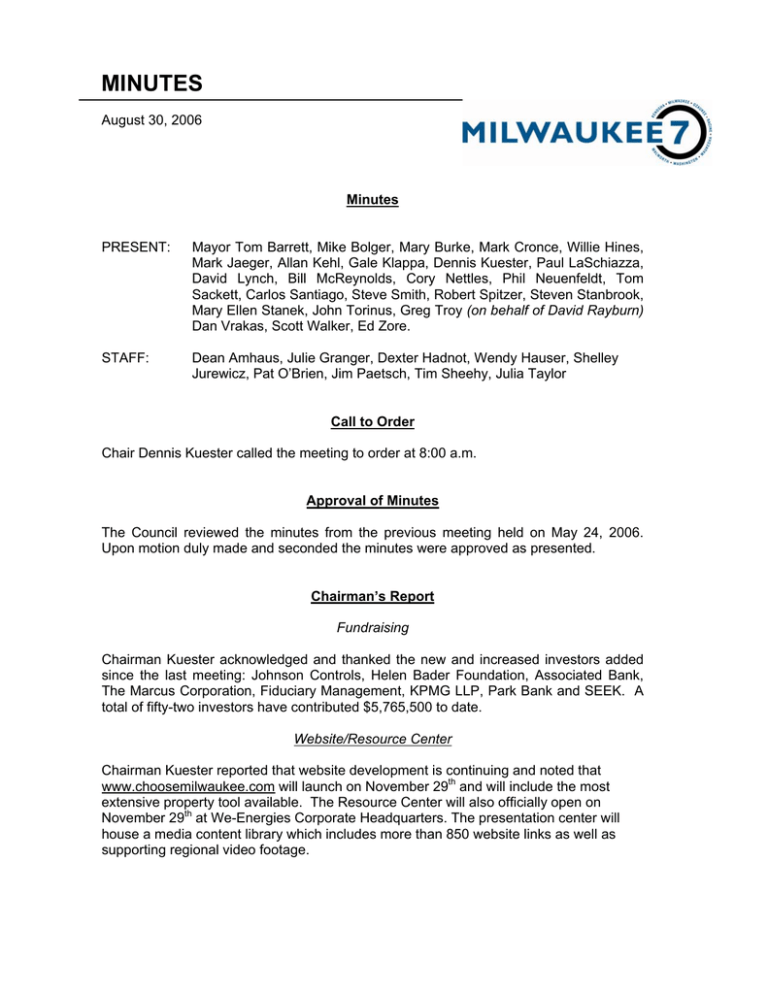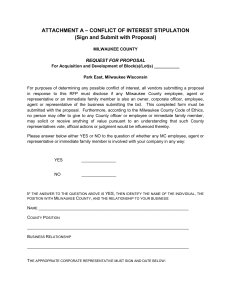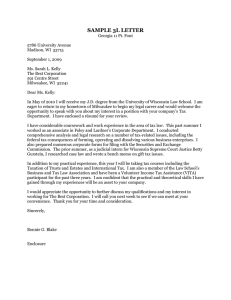August 30, 2006
advertisement

MINUTES August 30, 2006 Minutes PRESENT: Mayor Tom Barrett, Mike Bolger, Mary Burke, Mark Cronce, Willie Hines, Mark Jaeger, Allan Kehl, Gale Klappa, Dennis Kuester, Paul LaSchiazza, David Lynch, Bill McReynolds, Cory Nettles, Phil Neuenfeldt, Tom Sackett, Carlos Santiago, Steve Smith, Robert Spitzer, Steven Stanbrook, Mary Ellen Stanek, John Torinus, Greg Troy (on behalf of David Rayburn) Dan Vrakas, Scott Walker, Ed Zore. STAFF: Dean Amhaus, Julie Granger, Dexter Hadnot, Wendy Hauser, Shelley Jurewicz, Pat O’Brien, Jim Paetsch, Tim Sheehy, Julia Taylor Call to Order Chair Dennis Kuester called the meeting to order at 8:00 a.m. Approval of Minutes The Council reviewed the minutes from the previous meeting held on May 24, 2006. Upon motion duly made and seconded the minutes were approved as presented. Chairman’s Report Fundraising Chairman Kuester acknowledged and thanked the new and increased investors added since the last meeting: Johnson Controls, Helen Bader Foundation, Associated Bank, The Marcus Corporation, Fiduciary Management, KPMG LLP, Park Bank and SEEK. A total of fifty-two investors have contributed $5,765,500 to date. Website/Resource Center Chairman Kuester reported that website development is continuing and noted that www.choosemilwaukee.com will launch on November 29th and will include the most extensive property tool available. The Resource Center will also officially open on November 29th at We-Energies Corporate Headquarters. The presentation center will house a media content library which includes more than 850 website links as well as supporting regional video footage. Young Professionals of Milwaukee Continuing, Chairman Kuester reported that MMAC’s Young Professionals of Milwaukee is reorganizing in support of the Milwaukee 7 with a new purpose to position and establish the Milwaukee Region as a region of choice attractive to world-class talent. Their new name and infrastructure will be announced in September. Regional Workforce Alliance Chairman Kuester also reported that the Regional Workforce Alliance SE Wisconsin had been chosen as a recipient of a WIRED grant in the amount of $100,000 to align our workforce, educational and economic development efforts, noting that it was the first joint submittal to DOL for an Advanced Manufacturing training module. Regional Operating Protocol Proposal Waukesha County Executive Dan Vrakas emphasized that developing an operating protocol is essential for the Milwaukee region and another important element in making the Milwaukee 7 partnership a success. Based on best practices by Denver, St. Louis and Cincinnati, key county economic leaders have been tasked to develop these regional operating protocols and report back to the Council at the November meeting. Advanced Manufacturing Report Draft Findings Chairman Kuester prefaced the draft findings report presentation by noting that “growing your own” is at the heart of any successful economic development strategy, as 80% of our region’s growth will come from the 50,000 businesses that are already here. Continuing, he noted that Sam White, professor of urban planning at UWM and Associate Dean of the School of Continuing Studies has been studying changes in the regional economy for 25 years. Chairman Kuester then turned the program over to Mr. White for his presentation on the challenges and opportunities that surfaced as a result of his analysis of the data from our manufacturing CEO call program. Mr. White began his presentation by explaining that the first CEO call program had focused on the manufacturing sector not only because of its historical significance to the regional economy, but also because manufacturing represents 18% of the regions employment today and has a production value of over $15.4 billion per year. One hundred and seventy-seven (177) extensive personal interviews were conducted covering a range of topics including company background, workforce, sales, technology, innovation and business climate. Statistical data including job classifications, wages, exportation, supplier sourcing, intellectual property and other factors were also presented. Continuing, Mr. White stated that workforce was a significant concern with employers and it’s most critical challenges over the next three years were identified as: recruiting/retention, skilled workers, health care expense and looming retirements. Milwaukee 7 Council Meeting Minutes August 30, 2006 Page 2 In conclusion Mr. White summarized that if the Milwaukee 7 wants manufacturing to play a central role in our regional economic future, we must respond to multiple challenges: workforce supply and quality, taxes and health care costs, and a wide range of other topics including, but not limited to K-12 education, workforce training, public transit and rail freight service. Following Mr. White’s presentation, Dennis Kuester noted that we have now started our second and third groups of CEO visits to biomedical companies and businesses located downtown and can expect reports on these visits in the coming months. Strategic Planning Update Regional Vision Tim Sheehy provided insight on the elements of a regional vision. To be a world-class region of choice for talent, capital investment and business development driven by innovation, supportive infrastructure, diversity, high environmental standards and a highly productive workforce our vision needs to tie to a concrete set of performance measures. Economic Positioning Strategy Gale Klappa restated our original purpose, which was to develop a shared regional economic positioning vision and implementation strategy based on a comprehensive identification and analysis of our regional assets and economic opportunities. He reported that to date we have received regional input from over 100 voices including the Project Management Team, Resource Team, Ideation Session participants, individual interviews, roundtable focus groups and asked Council members for their feedback during today’s meeting. Mr. Klappa outlined the process overview of Phase 1 as follows: The Economic Asset & Opportunities Analysis o April – June ’06 Economic Asset Input & Analysis -Analyzed the region’s indigenous economic, human and physical assets to understand past & current planning efforts and assess regional knowledge o June – July ’06 Identify Shared Values & Challenges - A series of interviews and roundtables were conducted to gain a regional perspective and discuss emerging opportunities o July – August ’06 Economic Opportunities & Imperatives Analysis Professional synthesis and discussions to test the geographical positioning foundations and key opportunities. Milwaukee 7 Council Meeting Minutes August 30, 2006 Page 3 Innovation Economy We are at a place in time when we are adapting to an innovation economy, John Torinus continued; one based on intellectual capital and the ability to translate ideas into new technologies, products and services. The success of any place or region in the world economy is now more than ever dependent on its innovative capacity. He noted the four components that determine our innovative capacity: 1. Drivers & Knowledge: R&D driver corporations like GE, Rockwell, or Johnson Controls and academic research institutions like the Medical College or UWM. 2. Human Capital: Create and attain entrepreneurial to managerial talent, science superstars to marketing and business builders. Education systems that foster STEM as well as creativity. 3. Infrastructure: From IT capabilities, energy, transit to VC systems 4. Vibrant Place and Life Quality: Lastly, a vibrant place with attractive qualities and choices is more important today than ever. Continuing, Mr. Torinus added that the first findings and direction of the economic positioning strategy have been broken down into categories: Geo-economic Positioning Foundations and Key Regional Assets and Opportunities. Geo-economic Positioning Foundations Mr. Torinus introduced Council members representing each of the Milwaukee 7 counties, who briefly summarized each of the following Geo-economic Positioning Foundations: (detailed on the following page) • Continental Safety and Access • Renewable Resources • The Chicago-Milwaukee Megacity • A Collection of Coastal Cities • Great Lakes International Economy • Wisconsin Connection Milwaukee 7 Council Meeting Minutes August 30, 2006 Page 4 GeoEconomic Positioning Foundations GeoEconomic Positioning Foundations form the basis on which the region will build an innovation economy, grounded in our place-based assets and locational advantages. Leveraging Continental Safety and Access Our location in the continent provides shelter from natural disasters and central access to reach North American and global markets. Renewable Resources: Growing New Economies From Age-Old Resources We are at the convergence of three major natural assets that overwhelmingly shape our region's economy and culture. These assets provide renewable inputs to existing economies and will feed the rapidly emerging biobased industries. The Chicago-Milwaukee Megacity: Size Matters in the Global Economy Chicago-Milwaukee is one of the emerging global megacities as defined by the UN as places with a total population in access of 10 million. The sheer mass and cosmopolitanism of global megacities makes them strategic locations for corporations doing business on a global level. These megacities are also the hubs of technology, culture, finance, and creativity that will drive the world’s future innovation economy. Branding Ourselves as a Collection of Coastal Cities The M7 Region is home to a linked system of cities and markets that share the Lake Michigan coast, our region's defining natural asset. An opportunity exists to brand and market our region as an urban freshwater coast. Strengthening the Great Lakes International Economy with our Canadian Partner Canada is Wisconsin’s largest trade partner. The Great Lakes International Economy is one of the largest in the world, which together shares the largest supply of freshwater. Wisconsin Connection: Increasing our Return on Investment in the Knowledge Economy Our state's two largest metropolitan areas each offer unique assets which, if combined, would better position the region in the global economy. Our state can gain a greater return on investment by leveraging the science and early stage research of the Madison area with the M7 Region's ability to conduct applied research, build businesses, and take products to market. Following these presentations, Dennis Kuester introduced Clay Nesler, Vice President of Innovations Services at Johnson Controls, who facilitated group discussions with Council members. After allowing time for table talk, Council members were asked to provide their opinions on: 1.What was the most compelling information they heard and 2. What ideas presented resonated most with their community and the region overall. Assets and Opportunities Mr. Kuester then introduced Greg Flisram, with Vandewalle and Associates who presented our findings in the form of key regional assets, and our ideas in the form of economic opportunities. Key Assets: Corporate Anchors: We have a high concentration of top flight corporations who drive innovation within their respective industries and populate the region with a rich pool of creative and managerial talent. These c corporations are by far the major source of the region’s (and the state’s) innovation-economy as measured by total number of patents Knowledge: We have a strong collection of institutions of higher learning. These institutions have strengths in supplying our region with a broad spectrum of expertise in various domains including engineering, the sciences, management, finance, and the arts. We are experts in designing and making things, and building businesses. We hold particular strengths in applied research, prototype development, financial management, and IT. This provides us with a potentially healthy climate for interdisciplinary collaboration, innovation, and entrepreneurism. Natural Resources: Our three geographical zones contribute to the physical beauty of our region and make us one of the most self-sufficient places in the world. We have the ability to grow our own food, manage our own water, tap new sources of energy and make new products from new materials Infrastructure and Unique Skills: Our industrial history has left us with a muscular infrastructure of roads, railways, and ports. Our basic infrastructure is supplemented by a robust ‘info-structure’ of academic institutions and telecommunications networks. From a human capital standpoint, we have a strong artisan/craft-worker orientation and a growing technology workforce. Underutilized Workforce: Large portions of our population are chronically un/underemployed at the same time that we are facing a major exodus of baby boomers from the workforce. While it may take a major investment of time and resources to prepare many of these workers for jobs, we have the ability to replenish our labor force without having to rely on a large immigration. Japan, portions of Western Europe, and even parts of the US don’t have this same ability and are facing the very real prospect of a shrinking economy. Milwaukee 7 Council Meeting Minutes August 30, 2006 Page 6 55+ Knowledge and Capital: We have a large pool of ‘mature’ professional talent with specialized skills; particularly in the areas of engineering, finance and management. This group embodies much of the wealth and knowledge in our region. Many are reaching the pinnacle of their careers, and instead of contemplating retirement, are just hitting their stride. We need to get the maximize mileage out of these people. Many will embark on 2nd or 3rd careers in middle age. Many will have entrepreneurial interests and financial resources to pursue those interests. We need to ‘manage’ this asset and keep it working for the region. The Lake: Our most prized resource, our most distinguishing physical feature, identifier and source of recreation and celebration. It will help sustain our future growth when other parts of the US will be ‘drying up.’ Our lake is a potential focus for scientific research and economic development. According to a recent NYT article, water represents a $400 billion global market . Who better than us to take advantage of this? Cultural Diversity and Heritage: Around the turn of the 20th century, we were one of the most diverse regions in the US (2nd only to NYC in the number of foreign born residents). Successive waves of immigration have left their imprint on our cultural landscape - reflected in our Old World architecture, our food, our ethnic celebrations and our cultural traditions. We also have a thriving arts scene. Most of the emerging cities on the global stage have a palpable history and multiculturalism. Think of Prague, London, Copenhagen, SF, Boston. These are the “X-factors” that attract the young, ‘creative’ set, as well as new immigrants. We are fortunate to have kept much of our history alive; however, we need to call more attention to it and do a better job leveraging it. Underutilized Land and Infrasturcture: Due mostly to our changing economy and the physical spreading out of our region, these areas represent sunken public costs and lost value and we should be thinking about how to recapture their value. Many of these sites are in neighborhoods in dire need of jobs and reinvestment, and are often close to affordable housing, neighborhood services, and transit. The message to the business community should be that there is “no assembly required” and that we are already piped, paved, wired, and watered. All you really need to do is plug in and turn on the lights. This is a much different situation than in fast growth areas where public services and infrastructure has been maxed-out or struggling to keep up. Milwaukee 7 Council Meeting Minutes August 30, 2006 Page 7 Opportunities: o Leverage our corporate strengths to become a world player in clean and green. o Stake our claim and build our capacities in the bio-economy. o Engage our corporations and top talent to build businesses capitalizing on our private sector intellectual property. o Keep the boomers involved; build their entrepreneurial capacity. o Leverage Pier Wisconsin to ignite a stronger physical and economic relationship with the lake. o Build and program Life Ventures centers in our urban neighborhoods to point to new career futures. Following Vandewalle’s presentation, Clay Nesler again facilitated group discussions with Council members. After allowing time for table talk, Council members were again asked to provide their opinions on: 1.What was the most compelling information they heard and 2. What ideas presented resonated most with their community and the region overall. Next Steps – Phase II Eric Reisner of Johnson Controls spoke to the importance of this work from a corporate and investor point of view. Julia Taylor reported that work on Phase 2, to develop a Regional Economic Positioning Vision & Implementation Strategy, will begin immediately. Our timeline is to complete the economic position strategic process in April 2007. The steps we will take between now and then include o Continue to garner feedback and refine ideas o Develop regional vision o Prioritize ideas and develop implementation strategy including tactics, and the identification of measures and resources o Ground strategies “in place” leveraging our assets o Prepare strategic implementation document to launch the strategy Ms. Taylor reiterated that as in Phase 1, we will continue to involve voices and expertise from throughout the region including providing the Council updates and opportunities to provide insights and reactions. Milwaukee 7 Council Meeting Minutes August 30, 2006 Page 8 Ms. Taylor also confirmed that at the conclusion of this work in April we will: • • • Share a compelling regional economic vision Identify regional opportunities based on unique regional assets and ways to contribute to the regional vision Determine tactical strategies, roles, responsibilities and success measures Other Items of Discussion Mr. Kuester noted that the next meeting of the Milwaukee 7 Council will be held on November 29th, from 3:00 – 5:00 at We-Energies to celebrate the launch of the website and the opening of the Resource Center. A reception and tour of the Resource Center will follow immediately after the meeting. He added that the 2007 schedule is being developed and meetings will be held in Kenosha, Ozaukee, Walworth and Washington counties, with dates and venues yet to be determined. In closing Mr. Kuester thanked the members of the council for their participation in this very important work. Adjournment There being no further business to come before the Council, the meeting adjourned at noon. Respectfully submitted, Wendy Hauser GMC Program Officer Milwaukee 7 Council Meeting Minutes August 30, 2006 Page 9


